
Woodpeckers are a type of bird that lies within the Picadae family, with over 230 different species located on five continents. However, there are few places more ideal for woodpeckers than the woodsy and wetland-filled Pennsylvania. While there are plenty of woodpecker species throughout the continental US, today, we’ll be focusing on the eight types of woodpeckers in the Keystone State. While seven of these species are native, one only visits Pennsylvania in the winter.
A birdwatcher’s paradise, Pennsylvania has such a distinct array of habitat opportunities for our flying friends. The Appalachian Mountain Range runs within the state’s center, Lake Erie lies in the northwest, and there are plenty of dense woodlands in between.
So, let’s find out which species of woodpecker you can find the next time you’re strolling through a Pennsylvania forest. Bring out those binoculars!
1. Yellow-Bellied Sapsucker

The only sapsucker that lives in eastern North America is the yellow-bellied sapsucker.
©Christopher Unsworth/Shutterstock.com
Found only in North America, the sapsuckers are a special, tiny group of woodpeckers. There are only four types, and the yellow-bellied is the only one that’s found in eastern North America, as the other three occupy the West.
Sapsuckers have quite an important job, as they specialize in drilling small holes known as sap wells into the inner layer of tree trunks. Many other species of hummingbirds, as well as bats, squirrels, and nuthatches, depend on these wells for easy access to essential tree sap.
Identifying Traits and Features
Despite its name, this little hummingbird’s most distinct feature isn’t actually its underside. In fact, the yellowish hue found on these birds is quite subtle, and more often than not, its most distinguishing feature is actually the woodpecker’s black and white face. This, alongside the vertical white stripe that goes down its wing, is how you can spot them. In addition to this coloring, the birds also have bright red foreheads. Males also have red throats alongside those foreheads!
Where Can They Be Found?
Yellow-bellied sapsuckers migrate more than any other woodpecker native to Pennsylvania. They are most common in the early springtime but not in the summer, as they travel north to breed. Taking another Pennsylvania pitstop in early fall, they head back down south for winter.
While they are in Pennsylvania, you’ll find these hummingbirds most commonly in the state’s northern counties. They are usually found in woodlands, occupying conifers and deciduous northern hardwoods. If you do spot one in the southern parts of the state, it will more likely than not be within a mountain range.
Diet
These hummingbirds have a special way of securing their prey using tree sap to their advantage. As their name suggests, the yellow-bellied sapsucker will use the uniform holes they create in trees to trap passing insects. When they’ve gotten a few bugs caught up in their clever design, they come back to reap the benefits.
As omnivores, their insect diet consists of anything from beetles to spiders. However, they also enjoy snacking on the cambium, or the tree layer that falls directly beneath the bark. Occasionally, fruit and seeds are also on the menu.
2. Red-Headed Woodpecker

The oldest fossil found of a red-headed woodpecker was dated to be from two million years ago.
©vagabond54/Shutterstock.com
The red-headed woodpecker can be described in a lot of ways, but more than anything, they’re resilient. They are some of the only woodpeckers known to store food away, covered with wood or bark, and they are fierce survivalists. In fact, the oldest fossil found of this woodpecker is dated two million years in the past, and the oldest documented red-headed woodpecker lived to be nearly ten years of age!
Identifying Traits and Features
The red-headed woodpecker was named after their most distinguishing feature, and for good reason. Their bright red head is the only one out of the many eastern woodpeckers, a coloration that is as rare as it is beautiful. When they’re young, those heads have brown feathers, but they age into their signature scarlet in a mere few months.
The coloration of these woodpeckers is the same in both sexes. These colors have a distinct contrast, with their undersides and rump being bright white while their tail and wings are marginally black.
Where Can They Be Found?
A little-known fact about woodpeckers is that they prefer dying or dead trees to healthy ones. The red-headed woodpeckers in Pennsylvania are no different, and you can find them in any woodland area that has plenty of dying trees to choose from. It’s also important that they’re in an open environment, allowing lots of space to fly around.
These woodpeckers prefer quality over quantity, too. This means that you’re more likely to find them in an area with a few trees that have tall, wide trunks rather than an area with dozens of thin ones. This is typically going to be in the south-central Pennsylvania counties, the ones closest to the Mason-Dixon line. They aren’t commonly spotted in the northern areas of Pennsylvania, but there have been sightings in the northwest.
Diet
When a red-headed woodpecker is searching for a meal, you’re very likely to find them on the ground. They search for insects like cicadas and ants, and when the ground fails to provide, you might spot them snatching flying insects straight out of the air!
Since woodpeckers are omnivorous, they also ingest a large amount of plant matter. If you don’t see them snacking on a grasshopper, then you can find them chowing down on some seeds, berries, or acorns.
3. Hairy Woodpecker
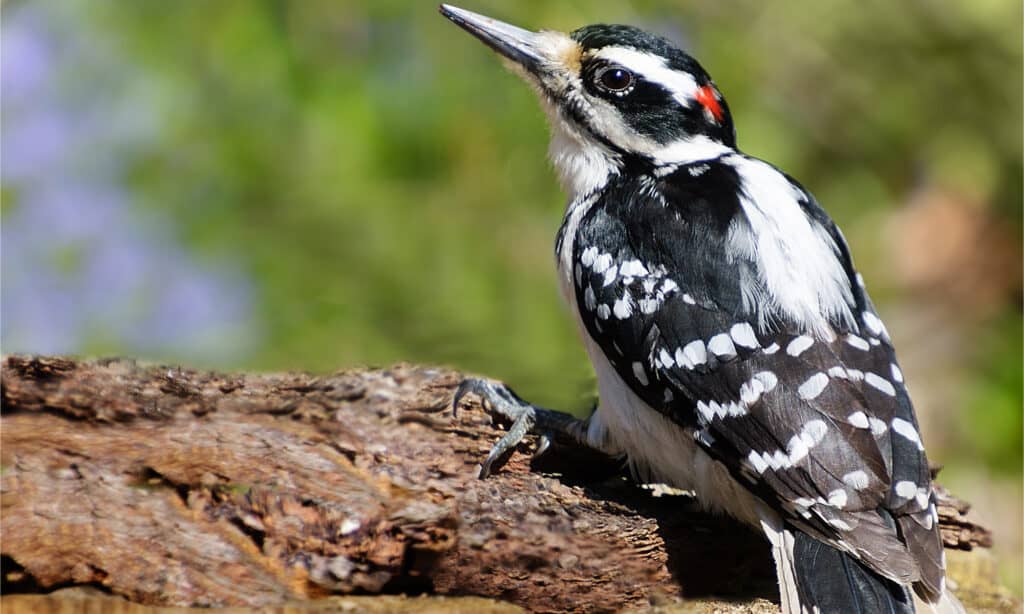
You can distinguish a male hairy woodpecker from a female one by the red spot on the back of males’ heads. Females lack the spot.
©K Quinn Ferris/Shutterstock.com
The hairy woodpecker is one of two woodpeckers in Pennsylvania that are strong lookalikes. We’ll discuss their counterpart, the downy woodpecker, in our next section. But for now, the larger and sturdier woodpecker is taking the spotlight.
Identifying Traits and Features
A Hairy Woodpecker can be identified by the large white stripe that runs down the center of its back. Their black eye markings can look almost mask-like, and they match the black crown across its head. Their belly and tail are white, and their wings are black with scattered white spots.
There is a way to distinguish between a male and a female hairy woodpecker. This can be done by locating the red spot that males have on the back of their heads. Females lack this red spot.
Where Can They Be Found?
Although it’s not uncommon for woodpeckers to migrate south for the winter, Hairy Woodpeckers in Pennsylvania typically stay put throughout the year. They, like most woodpeckers, can often be found in areas dense with aging trees. In particular, though, you can find these little guys most attracted to forests containing Douglas firs, hemlocks, and juniper trees.
Diet
Though hummingbirds are all omnivorous, some have their preferences! For the Hairy Woodpecker, insects are their favorite bite to eat. You can find these birds munching on moth pupae, caterpillars, beetles, or even wasps if they’re in a pinch! If they can’t find any bugs to eat while foraging through the branches and stumps, they can eat seeds and fruit as well.
4. Downy Woodpecker
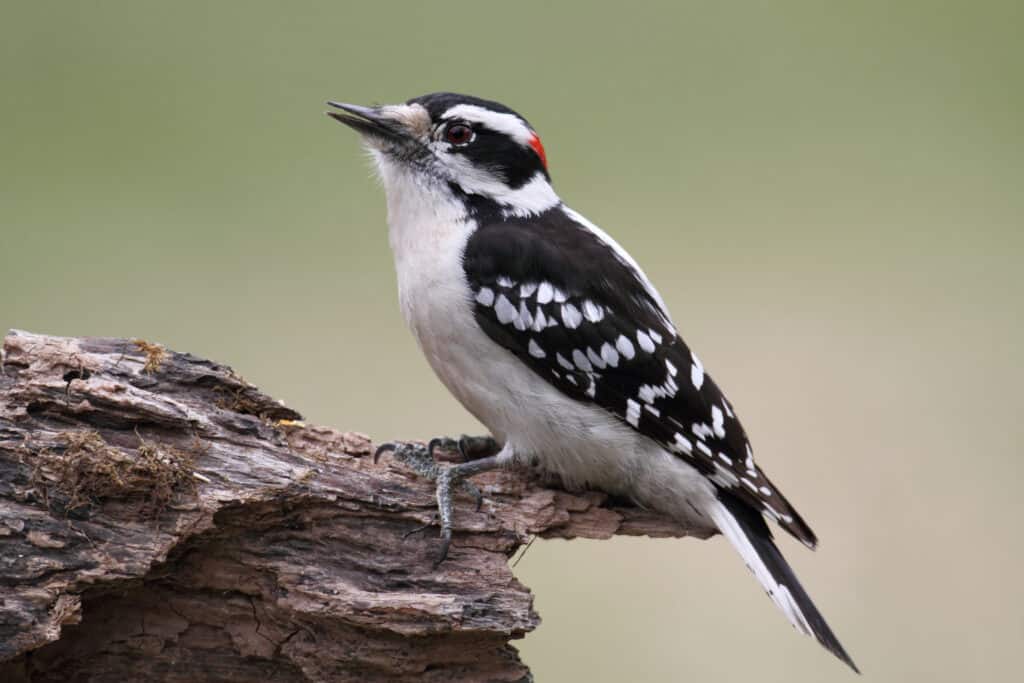
The distinction of smallest woodpecker in North America goes to downy woodpeckers.
©Steve Byland/Shutterstock.com
If you think you’re seeing double, you aren’t alone! Though the downy woodpecker has a large number of physical similarities to the hairy woodpecker, the two species are actually quite different in a number of ways. The largest distinction? Downy woodpeckers are the smallest in all of North America!
Identifying Traits and Features
As stated, these little guys have a striking similarity in coloring to the Hairy Woodpecker. The bird’s underside and head are white, with a black stripe going down its back and a black crown around its head. The two bird types also have the same sex distinction, as the male downy woodpecker has the signature red patch behind its head.
Another unique feature of these woodpeckers is their short bill. Almost chisel-like, the beak of the downy woodpecker is even shorter than the width of its head!
Where Can They Be Found?
If you live in North America, chances are you’ve run into one of these woodpeckers. The most common eastern woodpecker, they reside anywhere from a secluded forest to a populated suburb. They certainly aren’t picky!
As for these woodpeckers in Pennsylvania, they are spread out throughout the state, and they reside there throughout each season. In the winter months, they typically make their way toward any corn fields they can find. While they don’t care for conifer forests, you can certainly find them in wooded areas containing oak, hickory, maple, or hemlock trees.
Diet
Resourceful little birds, the downy woodpecker will grab their meals from trees or shrubbery. Though they might drill their own holes into wood to find insects, they usually don’t have a hard time grabbing them from the surface. They are omnivorous and have a taste for insects and produce alike.
5. Northern Flicker
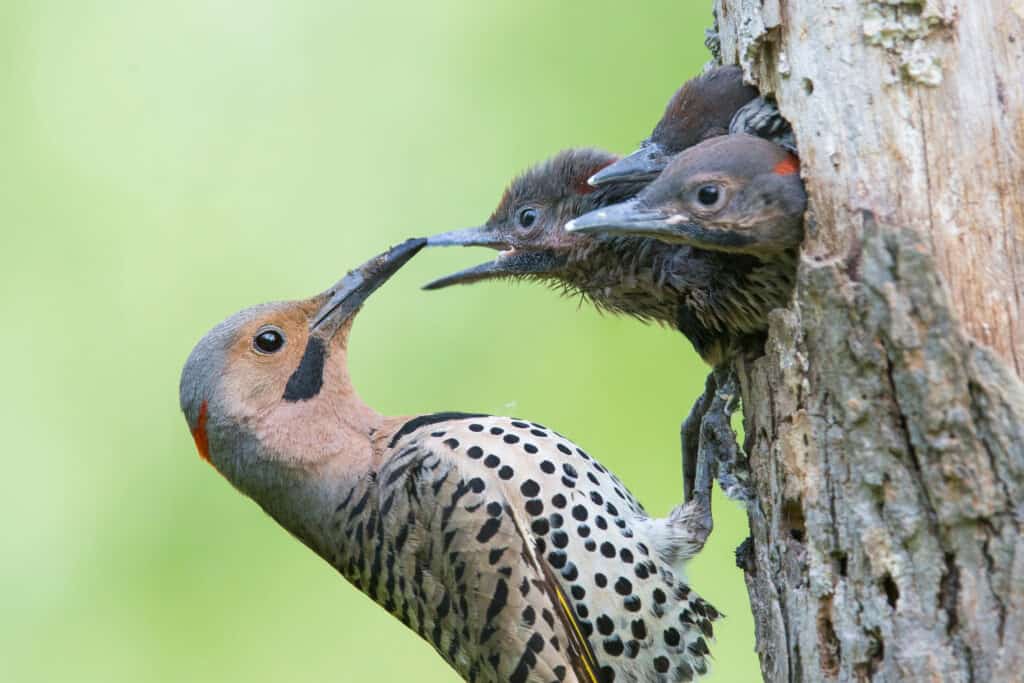
A number of features keep the northern flicker unique even amongst other woodpeckers, such as its shrill call.
©Mircea Costina/Shutterstock.com
The northern flicker gets its name from its loud, flickering call. Around two to seven times per minute, you’ll hear this bird get vocal with its shrill call. There are certainly other things that make this woodpecker so distinctive, though, like the fact that it prefers to hunt close to the ground as opposed to in the air or on tree branches.
Identifying Traits and Features
There are two kinds of flickers, usually separated by the distinguishing “yellow-shafted” or “red-shafted” trait. These woodpeckers in Pennsylvania, though, are of the yellow-shafted variety. They get this name because the feather shafts on their wings are yellow. When they fly by, you can see the yellow on the underside of their wings.
The bird has a brown back, brown wings, and a black band around their chest. They also have some red at the nape of their neck. To distinguish a male northern flicker from a female, you can find a black mark that goes across the top of their bill down to their throat. Funnily, it almost resembles a mustache.
Where Can They Be Found?
The northern flicker is known as a partial migrant, meaning some will travel south for the winter while some will stay in the same area. If you’re looking for one of these birds in Pennsylvania, your best bet is during the spring or summer months. Most of the time, these birds are rarely seen in the winter.
These woodpeckers are often residing on the edges of woodlands, with areas containing a large number of dead trees. It’s also not uncommon to spot them in open fields.
Diet
The way that these woodpeckers hunt is abnormal but interesting. Their diet consists mainly of ants, their favorite snack. Because their saliva counteracts the formic acid ants produce, they can munch away without worrying about adverse effects. They are also a fan of other insects and have even been known to eat the occasional snail.
6. Red-Bellied Woodpecker

While it’s faint, there is a red patch of plumage on the bellies of red-bellied woodpeckers.
©rck_953/Shutterstock.com
These woodpeckers in Pennsylvania are tiny, mighty, and great at storing food. With a 12-year lifespan, they can collect a lot of wisdom throughout their flight around the sun. Don’t let the image fool you, either! Despite the looks of it, the red-bellied woodpecker does, in fact, have a red patch on its belly.
Identifying Traits and Features
The red-bellied woodpecker has a black-and-white pattern across its wings and back. Their name comes from the faint red patch of feathers on its belly, and though it barely stands out against the much larger portion of gray, it still certainly made its mark.
To distinguish sex, the male red-bellied woodpeckers have red around the nape of their necks, extending into a red crown. The females, though, only have the red on their necks.
Where Can They Be Found?
Found across the eastern United States, these woodpeckers aren’t ones to migrate. They find their homes within mature forests of pine or hardwood and stick close to the ground.
Diet
Waste not, want not! This is a rule that these woodpeckers certainly follow, as they are known to store food away in tiny areas within their wooded homes. This can be things like fruits and seeds or even live insects. They forage for food by digging into surrounding tree bark, whether that be the limbs or trunk.
These woodpeckers aren’t afraid to be brutal, as they are known for going after larger prey than normal. To attack these larger creatures, they will slam their prey against a tree until it dies.
7. Pileated Woodpecker
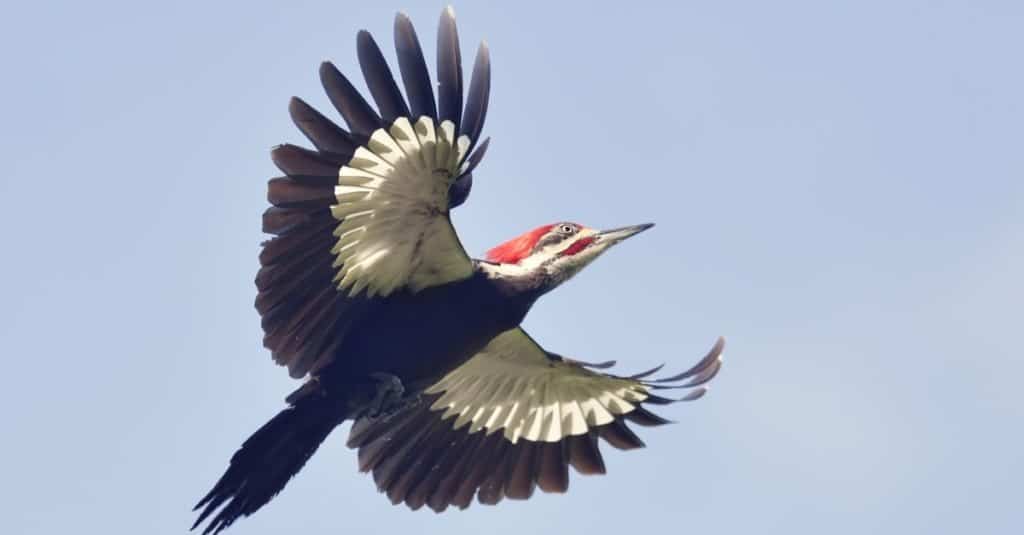
Red cheek patches of pileated woodpeckers are solely a trait of males.
©Svetlana Foote/Shutterstock.com
The pileated woodpecker boasts not only the largest mass in Pennsylvania but also in the United States. Coming in at 16-19 inches in length, their wingspan can reach up to 29 inches! Drumming loud and fast, you’ll be sure to hear it when one of these woodpeckers is nearby.
Identifying Traits and Features
Aside from its large frame, another easy way to identify these woodpeckers is by their gorgeous red crest. The underside of the woodpecker’s wings is white, but the remainder of its tail and back is solid black. If you’re looking to distinguish a male from a female, look for red cheek patches. These patches of red are exclusive to the male sex of this bird.
Where Can They Be Found?
These woodpeckers are not prone to migration. In fact, once they choose their home, they become quite territorial and defensive of that area. They are found in either a deciduous or coniferous forest, and the occasional hedgerow for foraging.
Diet
A classic omnivore, the pileated woodpecker has a diet that is split fairly evenly between insects and fruit. They often seek insects that live in surrounding wood, like beetles and larvae. However, if they want some fruit, they’ll go after something like dogwood berries or blackberries.
8. Black-Backed Woodpecker
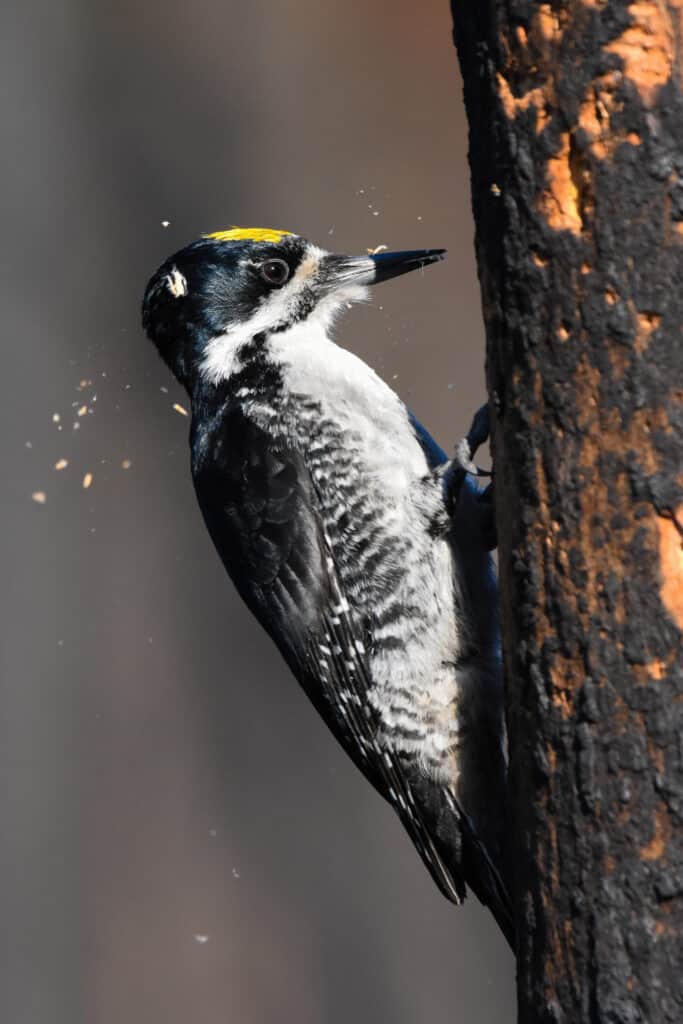
The black-backed woodpecker lives up to its name with the black plumage that covers its back.
©Carrie Olson/Shutterstock.com
Last but certainly not least, the black-backed woodpecker is one that is tiny but incredibly mighty. This three-toed woodpecker loves habitats in burnt forests and has a sharp and swift call that is very distinguishable.
Identifying Traits and Features
True to its name, these woodpeckers have a black back with slight white areas. Also white are the bird’s belly, throat, and sides. Their heads are black, but a white stripe runs from the nape of their necks up to their nostrils. Males have a yellow patch of feathers on their heads that females lack, and the female sex of this bird also has a notably shorter bill.
Where Can They Be Found?
Unlike the other woodpeckers in Pennsylvania on this list, the black-backed woodpecker isn’t native to the state. Instead, it is a visitor that will arrive if the conditions are satisfactory. These conditions are burnt forests, preferably forests that have burnt down within the past few years. In fact, they are simply attracted to fire-prone forests in general. They don’t habitually migrate, but they will intentionally leave to seek out newly burnt forests.
Diet
You might be wondering why these birds enjoy burnt forests to such a high degree. Well, put simply, it’s the best spot for them to find a meal! black-backed woodpeckers are insectivores. They feed on a variety of beetles, and these beetles are easily accessible to the birds by peeling back the bark of burnt trees. When there aren’t sufficient bugs to be found, they will revert to their omnivorous ways and snack on seeds or fruit. This certainly is not their preference, though.
Summary of Woodpeckers in Pennsylvania
| Common Name | Scientific Name | |
|---|---|---|
| 1. | Yellow-Bellied Sapsucker | Sphyrapicus varius |
| 2. | Red-Headed Woodpecker | Melanerpes erythrocephalus |
| 3. | Hairy Woodpecker | Leuconotopicus villosus |
| 4. | Downy Woodpecker | Dryobates pubescens |
| 5. | Northern Flicker | Colaptes auratus |
| 6. | Red-Bellied Woodpecker | Melanerpes carolinus |
| 7. | Pileated Woodpecker | Dryocopus pileatus |
| 8. | Black-Backed Woodpecker | Picoides arcticus |
The photo featured at the top of this post is © Vlad G/Shutterstock.com
Thank you for reading! Have some feedback for us? Contact the AZ Animals editorial team.







